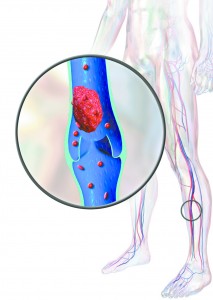 For more than a decade, the month of March has been dedicated to spreading awareness of deep vein thrombosis (DVT). It is important for you to learn how DVT affects the body, the risk factors of developing the condition, and how to prevent it.
For more than a decade, the month of March has been dedicated to spreading awareness of deep vein thrombosis (DVT). It is important for you to learn how DVT affects the body, the risk factors of developing the condition, and how to prevent it.
Since 2003, more than 25 major health care organizations have collaborated to make the public more aware of deep vein thrombosis. Many people are surprised to learn that hundreds of thousands of Americans die from DVT and its complications each year. Even more surprising, to many, is that DVT is initially preventable, and subsequently treatable as the impact of the morbidity progresses.
The more educated the general public becomes about DVT causes, symptoms, and preventative measures, the more likely they are to get a venous health screening to avoid becoming a DVT statistic.
What do I need to know about DVT?
DVT is an important public health problem, yet surprisingly; nearly three-quarters of Americans are unaware of DVT. And of those who are aware, more than half are unable to identify common risk factors or pre-existing conditions that can lead to the development of this condition.
Most people think of varicose or spider veins when they think of vein disease. While these swollen, discolored veins are the most well-known form of vein disease, DVT represents a far larger threat to those affected by it. Deep vein thrombosis, as its name implies, occurs in the larger, deeper veins of the legs, where it cannot be seen the way we can see the surface varicose veins. DVT occurs when a blood clot forms in one of the large veins, usually in the lower limbs, partially or completely blocking circulation. Pulmonary embolism, a serious complication from DVT, can occur when a fragment of a blood clot migrates to the lungs, where it blocks a pulmonary artery. DVT and pulmonary embolism may be responsible for as many as 200,000 deaths annually in the United States. Up to 10-30% of these deaths occur within a month of being diagnosed with DVT.
What causes DVT and how can I prevent it?
These are the questions that we hope everyone who reads this article asks themselves. You are at increased risk of developing DVT if you have a family history of blood clots or other vein diseases (including varicose veins). DVT may be caused by a variety of risk factors and triggering events, including increasing age, obesity or restricted mobility due to acute medical illness, stroke, major surgery or prolonged travel in cramped spaces. Not getting regular exercise, sitting for long periods of time, giving birth within the past six months, smoking cigarettes, and taking birth control medications can also increase the risk for developing DVT. Symptoms of DVT include pain, swelling, tenderness, discoloration of the affected area and skin that is warm to the touch.
The first step of preventing DVT is to evaluate your personal risk for developing the condition with a physician. If you experience any signs or symptoms, a complete evaluation should be performed, including an ultrasound look beneath the surface of your skin and check to see whether your blood is flowing properly, or whether there are obstructions to it. If the ultrasound helps determine that you are not affected by DVT, there are many things that you can do to reduce your risk of getting it in the future. A vascular specialist can tell you the best ways to lower your chances of developing DVT.
If you have DVT, or the symptoms of DVT, it is always important to schedule regular appointments with a physician, take all medications as prescribed, get up and get moving on a daily basis, use compression stockings if needed to prevent leg swelling.
DVT is an unknown threat to many unsuspecting Americans, educating the public of the causes, symptoms, risk factors, and preventative measures is important. There are clear identifiable risks for DVT, and things that you can proactively do to prevent this potentially fatal condition. If you have any questions, or would like to simply learn more about DVT and your chances of developing clots, please call 352-750-2040 today! We are happy to address any concerns you might have.
Did you know?
• Blood clots affect upwards of 600,000 Americans each year and cause more deaths each year than the more well-publicized conditions of breast cancer, AIDS, and motor vehicle accidents.
• Blood clots are a leading cause of preventable hospital deaths in the United States.
• Blood clots are the leading cause of maternal death in the United States.
• One-half of clot patients will have long-term complications and one-third will have a recurrence within 10 years.
• An estimated $10 billion in medical costs in the US each year can be attributed to treating patients with blood clots.
Dr. Vallabhan
Rolling Oaks Professional Park
929 N US HWY 441, Suite 201
Lady Lake, FL 32159
(352) 750-2040
Check Also
Recurrent UTIs: Addressing the Risk of Antibiotic Resistance
Urinary tract infections (UTIs) are common bacterial infections that affect millions of individuals worldwide each …
 Central Florida Health and Wellness Magazine Health and Wellness Articles of the Villages
Central Florida Health and Wellness Magazine Health and Wellness Articles of the Villages



